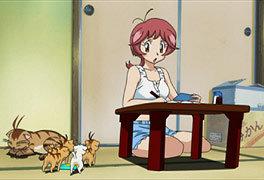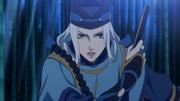A thorough evaluation of the unusual story of the Yoshida Palace! What is its appeal as a tale of warrior training?

The appeal and evaluation of "The Tale of the Yoshida Palace (title changed/The Tale of the Military Training)"OverviewThe Tale of the Yoshida Palace (Retitled "The Tale of Musha Shugyo") is a Japanese animated film released on April 27, 1928. It is based on a novel and was distributed by Chuo Eigasha. It was directed by Ofuji Noburo and produced by his production company. The film is a one-episode story and was released theatrically. storyThe story begins with Dangobei, the son of a farmer, setting out on a journey to train as a warrior in order to advance in society. After encountering a pack of wolves in the mountains and taking refuge in Tsujido, Dangobei is greeted by a maid who, after the wolves have left, speaks of a princess praying to be rescued from peril. Hearing this, Dangobei devises a plan and, using the voice of a god, announces to the castle that a brave man named Dangobei is going to rescue the princess. The next day, he goes to the castle, which he finds to be the Yoshida Palace, where it is rumored that a monster called a Higane lives. Terrified, he tries to run away, but is found by his messenger, who asks him to rescue the princess. When he enters the cave where the monster lives, he finds a samurai named Yokotoriemon who has already been captured, so he rescues him. While Dangobei is fighting the monster, the other samurai rescues the princess and disguises himself as her son-in-law. After finally defeating the monster, he returns to the palace and explains what has happened, but they do not believe him, and he is thrown out of the castle and returns home in despair. This is the story of how he gives up his ambition to become a samurai and goes back to being a farmer. CommentaryThis animation has the subtitle "Nonkihotei" and is said to be the Japanese version of Don Quixote. Dangobei's adventures and setbacks reflect the social situation at the time and the gap between people's dreams and reality. In addition, fantasy elements such as monsters and ghosts add depth to the story. Evaluation and Appeal"A Tale of a Warrior's Training" is praised for its unique storytelling and compelling characters. Dangobei's pure heart and courage move audiences. The battles with monsters and demons are visually appealing and of very high quality considering the technical standards of the time. As the subtitle "The Japanese version of Don Quixote" suggests, this work depicts a man torn between dreams and reality. Dangobei's adventures reflect the feelings of many people who strive for success and are easy to empathize with. The development and ending of the story also reflect the social situation of the time, making it of great historical value. BackgroundDirector Ofuji Nobuo tried to portray the social issues and people's dreams of the time through this work. His productions focused on both technical challenges and storytelling, and this work was the result. Another important point was that it was distributed by Chuo Eigasha, which allowed it to be seen by a large number of people. Character IntroductionDangobeiThe protagonist, Dangobei, is an innocent young man born into a peasant family, but dreams of success in life. His courage and wisdom are at the heart of the story, inspiring the audience. Dangobei's adventures symbolize the human condition, torn between dreams and reality. Yokotori UemonYokotoriemon is a samurai whom Dangobei ends up helping. He plays a key role in the story by rescuing the princess and masquerading as her son-in-law. Yokotoriemon's actions portray the complexity of human nature, and his contrast with Dangobei adds depth to the story. princessThe princess is an important character whom Dangobei tries to save. Her existence is the objective of Dangobei's adventure and a central element of the story. The princess's peril and rescue add to the tension of the story. Animation TechnologyConsidering the technical standards of 1928, the animation in this work can be said to be of very high quality. In particular, the depictions of monsters and demons are visually enjoyable and show the technological capabilities of the time. Furthermore, Dangobei's facial expressions and movements are drawn in detail, successfully conveying the character's emotions. Social BackgroundThe film was released in 1928, a time of great social upheaval, marking the transition from Taisho democracy to the Showa era. Dangobei's quest for success reflects the gap between the dreams and reality of people at the time, and contains a social message. In addition, fantasy elements such as monsters and ghosts satisfied people's demand for entertainment at the time. Impact and Evaluation"A Tale of a Warrior's Training" is highly acclaimed for its unique storytelling and appealing characters. Dangobei's pure heart and courage in particular touched audiences and earned him a great reputation. The battles with monsters and demons are visually enjoyable and of very high quality considering the technical standards of the time. As the subtitle "The Japanese version of Don Quixote" suggests, this work depicts a man torn between dreams and reality. Dangobei's adventures reflect the feelings of many people who strive for success and are easy to empathize with. The development and ending of the story also reflect the social situation of the time, making it of great historical value. Reasons for recommendation"A Tale of Military Training: Yoshida Palace" (title changed) is a work that depicts the adventures of Dangobei, a man of pure heart and courage, and portrays a human being torn between dreams and reality. In particular, the battles with monsters and demons are visually enjoyable, and are of very high quality considering the technical standards of the time. Furthermore, the development and ending of the story reflect the social situation of the time, making it of great historical value. As the subtitle "The Japanese version of Don Quixote" suggests, this work depicts a man torn between dreams and reality. Dangobei's adventures reflect the feelings of many people who strive for success and are easy to empathize with. The development and ending of the story also reflect the social situation of the time, making it of great historical value. Related TitlesThe following are works related to "The Strange Story of the Yoshida Palace (title changed/A Tale of Warrior Training)".
summary"A Strange Tale of Yoshida Palace (Retitled: A Tale of Warrior Training)" depicts Dangobei's pure heart and courage, and the figure of a man torn between dreams and reality. In particular, the battles with monsters and demons are visually enjoyable, and are of very high quality considering the level of technology at the time. Furthermore, the development and ending of the story reflect the social situation at the time, and it is of great historical value. As the subtitle "The Japanese version of Don Quixote" indicates, this work depicts the figure of a man torn between dreams and reality. Dangobei's adventures reflect the feelings of many people who aim for success, and are easy to empathize with. Furthermore, the development and ending of the story reflect the social situation at the time, and it is of great historical value. Please enjoy this work and feel Dangobei's adventures and dreams. |
>>: Spring in Edo: The appeal and reputation of historical anime
Recommend
The movie "Dying to Survive" was fined 20,000 yuan for copyright infringement on its fourth anniversary
According to a report by China News Network on Ju...
The appeal and reviews of "Mamotte Shugogetten!" - A must-see anime introduction
The appeal and evaluation of "Mamotte Shugog...
The latest trailer of the live-action movie "Kingdom 2" will be released on July 15
The second live-action movie of "Kingdom&quo...
JOJO spin-off "Kishibe Rohan Motionless" new trailer will be released on May 26
The live-action movie "Kishibe Rohan: Trip t...
Charlie and the Chocolate Factory prequel Wonka confirmed to be released on Tuesday
Sina Film announced today (November 3) that the p...
This also violates intellectual property rights. A Japanese woman was sued for making and selling "Demon Slayer" themed cakes
It is not uncommon to celebrate a friend's bi...
The appeal and evaluation of "Bakuman. (2)": The success and evolution of the sequel
Bakuman. (2) - A youth drama set between dreams a...
The bloodiness is comparable to Mortal Kombat! New trailer for Hellboy: Rise of the Blood Queen
The American super "Red Boy" Hellboy ha...
The new TV animation of "Spice and Wolf" will be broadcast on April 2
The new TV animation of "Spice and Wolf"...
Youku 4K restored version of the film and television list released: Black Cat Sheriff, The Legend of Sword and Fairy 1, The Condor Heroes, etc.
Today is Children's Day, and Youku has releas...
The ninth part of "JoJo's Bizarre Adventure" is temporarily named "JoJo Lands"
The ninth part of "JOJO's Bizarre Advent...
Sony announced that Venom will be released in China on November 9, and Tencent will invest up to 25%
News Update: Sony Columbia Pictures has just anno...
It is reported that a new live-action movie project of "Resident Evil" is in production
According to foreign media Sudbury recently repor...
The new work of the classic animation "Trigun" released concept map and will be broadcast next year
The classic anime "Trigun" previously a...
The appeal and reviews of "To Heart2 adplus Short Story": A moving experience that fans must see
To Heart2 adplus Short Story - The fascinating wo...









